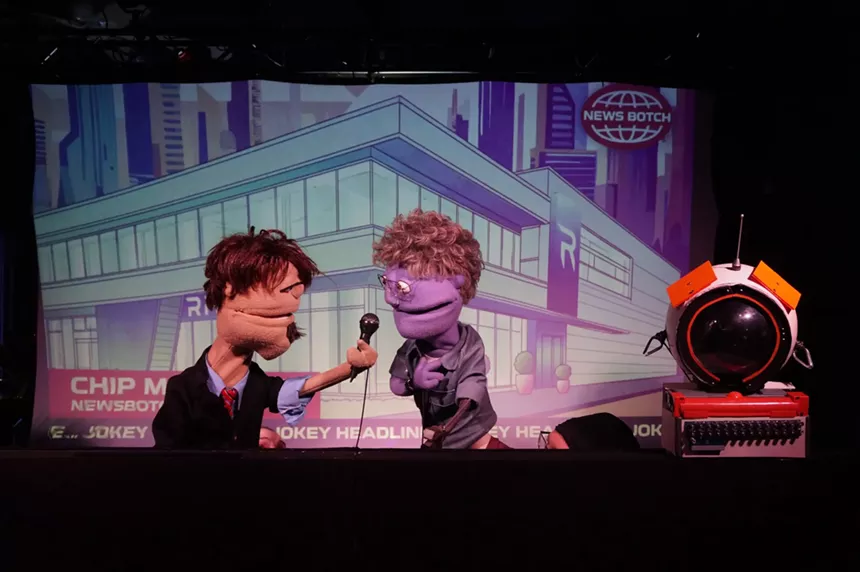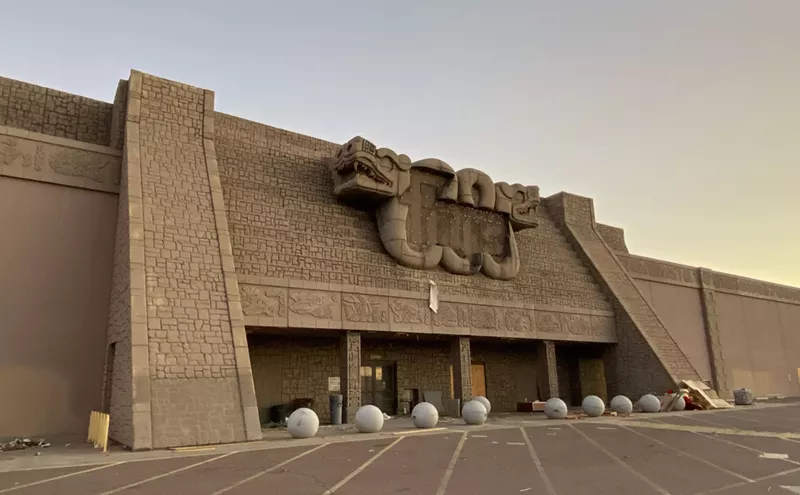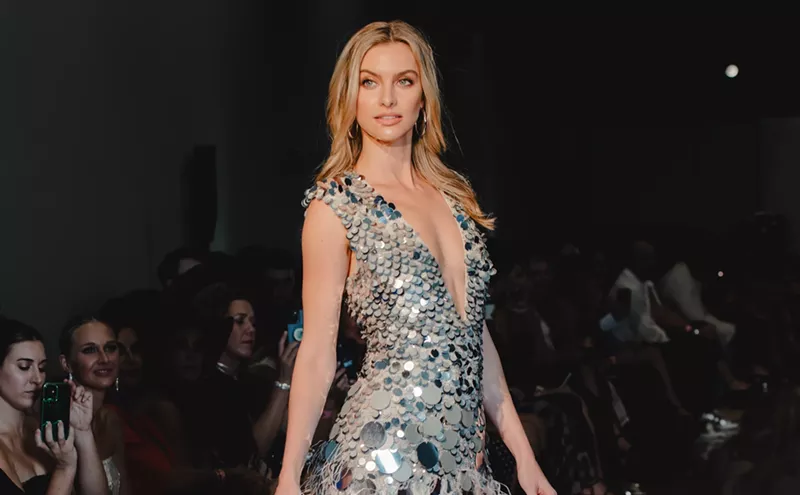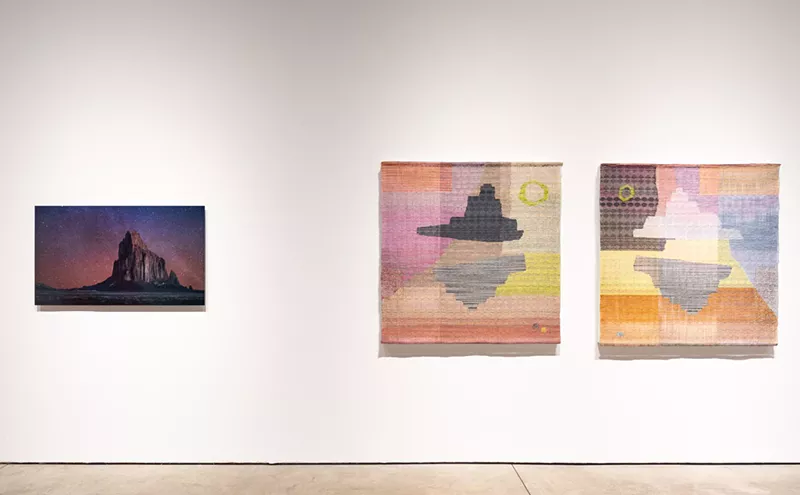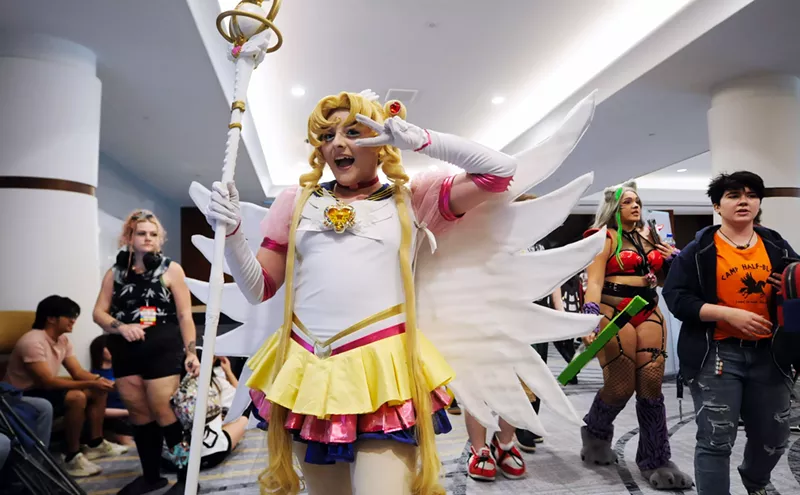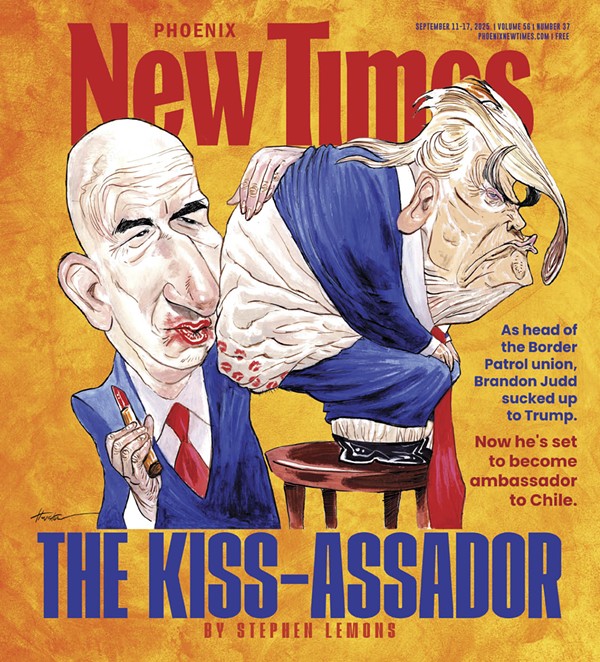A.I. and the apocalypse: They're topics that have been impossible to avoid this year. It seems not a day goes by without someone insisting that A.I. is the future, while so many other ominous things around us (climate change, genocide, the rising tide of fascism, the continuing popularity of Morgan Wallen’s music) make us question how much of a future is left for any of us. The robots are coming and the national vibes are in the toilet. Who will save us from the Robopocalypse?
Puppeteers for Fears won’t be bringing us salvation from 2025’s many ills, but they will be bringing wild sounds and felt-covered comedy to Phoenix on Friday, Aug. 29, when they bring their show "Robopocalypse: The Musical!" to Valley Bar.
Based in Ashland, Oregon, Puppeteers for Fears is a theater company that specializes in marrying the peanut butter of musical comedy with the dark chocolate of puppetry. The group tours with a full cast and a live band, putting on R-rated sci-fi/horror shows that are not intended for children (“unless they’re awesome,” quips the website).
Having already invoked the cosmic horror of Lovecraft in their hit show "Cthulhu: The Musical," Puppeteers for Fears is now bringing digital nightmares to life. Move over, Nyarlathotep: It’s Roko’s Basilisk’s time to shine. Puppeteers for Fears writer and Artistic Director Josh Gross spoke with us recently about "Robopocalypse," his change of heart about puppets and why people let puppets get away with murder.
Phoenix New Times: Let’s start with the origins of the show. What inspired the writing and vision of Robopocalypse?
Josh Gross: The origins of "Robopocalyse" had to do with the origins of the company as a whole, which, when we started, was intended to be a one-night-only Halloween show. It was just a series of short sketches about mummies, werewolves and serial killers. It proved so popular that we decided to turn it into a dedicated company. My principal collaborator at the time, we got together and we’re like, "OK, if this is going to be a full company, what would that look like?"
We sketched it out like you’d do a multiseason arc. Like, if we’re gonna do this for three seasons, what are the things we’d want to do each season?
And part of that process was us coming up with a series of monsters — cryptids — and themes that we thought would make for fun, show-worthy material. We liked monsters that didn’t have a fixed story attached to them. If you’ve seen Dracula, you know the story of Dracula, right? But Bigfoot doesn’t have a story of Bigfoot.
We also looked for things that suggested some kind of aesthetic presentation style. When we did "Cthulhu: The Musical," the music was this sort of psychedelic doom rock. One of the big things we always wanted to do was something with cyberpunk or artificial intelligence because it suggested all of these great visual themes from 1980s cyberpunk films like "Blade Runner" and "Tron." And those aesthetics suggested a music style: very synthesizer-driven electronic pop music. ... There was a lot of fertile ground for us to play with — the story of the robots and artificial intelligence. No one has ever really seen this as a puppet show, you know — not the way that we’re gonna do it, anyway.
Do you all determine the musical style of the show based on the content/theme like you did here, or does it precede it? Like do you make a show with a certain sound already in mind?
Every show that we’ve done, we’ve tried to lean into the aesthetic choices with the music. With this one, it suggested the idea of electronic music. I’ve always loved synthesizers as a music fan, but I never knew how to play them. So, one of the things I did with this show is I challenged myself to write the entire score on an analog synthesizer, which at the time was an instrument I did not even own, let alone know how to play.
There were definitely moments when I was like "Oh, God, what have I gotten myself into?" But it also helped me approach it with a beginner’s mind. One of the things I quickly learned was there’s a reason that a lot of people don’t write stage musicals on analog synths. It’s because it’s an unwieldy beast. It’s not an instrument you play so much as it is a wave you just try to surf as long as you can.
In a documentary about the troupe, you mentioned that when you were first approached to do a puppet show, you were kind of skeptical about working with puppets. Having worked with them as long as you have now, how has your relationship to puppetry as a medium evolved?
Initially, I came to it with a lot of the skepticism that people have, which is that it seems like kiddie stuff. I’ve really come to appreciate the complexity of the art form. The amount of talent it takes to be able to do that sort of movement-based communication — the people who tend to thrive in puppetry often have a background in things like dance or mime because you have to communicate so much through physical movements in a way that’s really sophisticated. And there’s also a sort of transhumanist quality to it where you’re projecting this character, this humanity, onto this other thing.
The thing that’s really been the most fascinating for me is realizing all of the opportunities that it provides you that you can’t get with just standard human performers on stage. Puppets exist in this meta space between reality and simulation. I often say they’re kind of like the cartoons in "Who Framed Roger Rabbit?" People understand that they’re not real but the magic is that the performers are so good that the audience starts to see them as real. Sometimes when we bring the puppets out after the show, people will start talking to the puppet itself, not to the actor.
That’s because it hacks your brain in a strange way. And that means you can do a lot of things with them you wouldn’t be able to do with a regular actor because people receive them differently, so it opens up entire new possibilities for narratives, comedy and characters. Anything can be a puppet: Why have a puppet that’s just a person when it could be a talking chair? And that opens up all of these possibilities — you get to go, "What is the inner life of a chair like?"
That meta space you mentioned: Do you think audiences give puppet characters more leeway to do things because they’re perceived as childish and not real? Like, if a human actor “ate” a baby, that’s horrifying, but if a puppet did it…
Yeah, absolutely. If you see a stick figure get its head chopped off, no one goes "Oh my God! I’m traumatized for life!" That’s the liminal space of puppetry where people go, "OK, I know this isn’t real," so it softens the blow. No one watches "Tom and Jerry" and goes, "These poor animals are being abused."
It’s interesting with this particular piece because we’re talking about artificial intelligence, which has this question of: Is it real or a simulation? Especially when you get into things like virtual reality — if it’s happening to your brain, is it real or are you being lied to? Puppets are the perfect medium to explore that because they exist in a similar space.
"Robopocalypse: The Musical!": Puppeteers for Fears at 6:30 p.m. Friday, Aug. 29, at Valley Bar, 130 N. Central Ave. Doors open at 6 p.m. Tickets are $20 in advance via Ticketweb or $25 at the door.

Audio By Carbonatix
[
{
"name": "GPT - Billboard - Slot Inline - Content - Labeled - No Desktop",
"component": "21251496",
"insertPoint": "2",
"requiredCountToDisplay": "2"
},{
"name": "STN Player - Float - Mobile Only ",
"component": "21327862",
"insertPoint": "2",
"requiredCountToDisplay": "2"
},{
"name": "Editor Picks",
"component": "16759093",
"insertPoint": "4",
"requiredCountToDisplay": "1"
},{
"name": "Inline Links",
"component": "17980324",
"insertPoint": "8th",
"startingPoint": 8,
"requiredCountToDisplay": "7",
"maxInsertions": 25
},{
"name": "GPT - 2x Rectangles Desktop, Tower on Mobile - Labeled",
"component": "21934225",
"insertPoint": "8th",
"startingPoint": 8,
"requiredCountToDisplay": "7",
"maxInsertions": 25
},{
"name": "Inline Links",
"component": "17980324",
"insertPoint": "8th",
"startingPoint": 12,
"requiredCountToDisplay": "11",
"maxInsertions": 25
},{
"name": "GPT - Leaderboard to Tower - Slot Auto-select - Labeled",
"component": "17012245",
"insertPoint": "8th",
"startingPoint": 12,
"requiredCountToDisplay": "11",
"maxInsertions": 25
}
]


